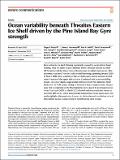Ocean variability beneath Thwaites Eastern Ice Shelf driven by the Pine Island Bay Gyre strength
Abstract
West Antarctic ice-shelf thinning is primarily caused by ocean-driven basal melting. Here we assess ocean variability below Thwaites Eastern Ice Shelf (TEIS) and reveal the importance of local ocean circulation and sea-ice. Measurements obtained from two sub-ice-shelf moorings, spanning January 2020 to March 2021, show warming of the ice-shelf cavity and an increase in meltwater fraction of the upper sub-ice layer. Combined with ocean modelling results, our observations suggest that meltwater from Pine Island Ice Shelf feeds into the TEIS cavity, adding to horizontal heat transport there. We propose that a weakening of the Pine Island Bay gyre caused by prolonged sea-ice cover from April 2020 to March 2021 allowed meltwater-enriched waters to enter the TEIS cavity, which increased the temperature of the upper layer. Our study highlights the sensitivity of ocean circulation beneath ice shelves to local atmosphere-sea-ice-ocean forcing in neighbouring open oceans.
Citation
Dotto , T S , Heywood , K J , Hall , R A , Scambos , T A , Zheng , Y , Nakayama , Y , Hyogo , S , Snow , T , Wahlin , A K , Wild , C , Truffer , M , Muto , A , Alley , K E , Boehme , L , Bortolotto , G A , Tyler , S W & Pettit , E 2022 , ' Ocean variability beneath Thwaites Eastern Ice Shelf driven by the Pine Island Bay Gyre strength ' , Nature Communications , vol. 13 , 7840 . https://doi.org/10.1038/s41467-022-35499-5
Publication
Nature Communications
Status
Peer reviewed
ISSN
2041-1723Type
Journal article
Description
Funding: T.A.S., T.S., C.W., M.T., A.M., K.E.A., S.W.T., and E.P. thank the support from National Science Foundation (NSF) Grant 1929991. T.S.D., K.J.H., R.A.H., and A.K.W. thank the support from Natural Environment Research Council (NERC) Grant NE/S006419/1. L.B. and G.A.B. thank support from NERC Grant NE/S006591/1. Y.Z. acknowledges support from the China Scholarship Council, the University of East Anglia, and the European Research Council (under H2020-EU.1.1.; Grant 741120). Y.N. received support from the Grants-in-Aid for Scientific Research (19K23447, 21K13989) of the Japanese Ministry of Education, Culture, Sports, Science, and Technology. S.H. was supported by JST, the establishment of university fellowships towards the creation of science and technology innovation (Grant JPMJFS2101). Logistics were provided by NSF-U.S. Antarctic Program and NERC-British Antarctic Survey. ITGC Contribution No. ITGC-062.Collections
Items in the St Andrews Research Repository are protected by copyright, with all rights reserved, unless otherwise indicated.

